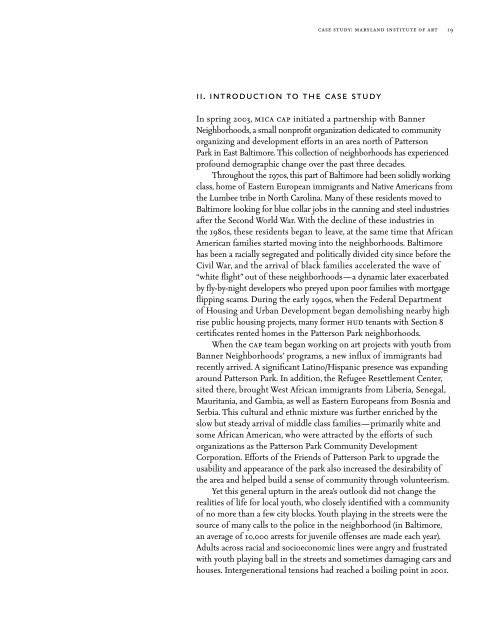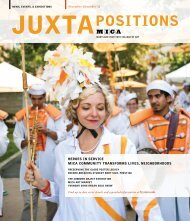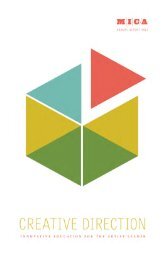art/vision/voice - Maryland Institute College of Art
art/vision/voice - Maryland Institute College of Art
art/vision/voice - Maryland Institute College of Art
Create successful ePaper yourself
Turn your PDF publications into a flip-book with our unique Google optimized e-Paper software.
ii. introduction to the case study<br />
case study: maryland institute <strong>of</strong> <strong>art</strong> 19<br />
In spring 2003, mica cap initiated a p<strong>art</strong>nership with Banner<br />
Neighborhoods, a small nonpr<strong>of</strong>it organization dedicated to community<br />
organizing and development efforts in an area north <strong>of</strong> Patterson<br />
Park in East Baltimore. This collection <strong>of</strong> neighborhoods has experienced<br />
pr<strong>of</strong>ound demographic change over the past three decades.<br />
Throughout the 1970s, this p<strong>art</strong> <strong>of</strong> Baltimore had been solidly working<br />
class, home <strong>of</strong> Eastern European immigrants and Native Americans from<br />
the Lumbee tribe in North Carolina. Many <strong>of</strong> these residents moved to<br />
Baltimore looking for blue collar jobs in the canning and steel industries<br />
after the Second World War. With the decline <strong>of</strong> these industries in<br />
the 1980s, these residents began to leave, at the same time that African<br />
American families st<strong>art</strong>ed moving into the neighborhoods. Baltimore<br />
has been a racially segregated and politically divided city since before the<br />
Civil War, and the arrival <strong>of</strong> black families accelerated the wave <strong>of</strong><br />
“white flight” out <strong>of</strong> these neighborhoods—a dynamic later exacerbated<br />
by fly-by-night developers who preyed upon poor families with mortgage<br />
flipping scams. During the early 1990s, when the Federal Dep<strong>art</strong>ment<br />
<strong>of</strong> Housing and Urban Development began demolishing nearby high<br />
rise public housing projects, many former hud tenants with Section 8<br />
certificates rented homes in the Patterson Park neighborhoods.<br />
When the cap team began working on <strong>art</strong> projects with youth from<br />
Banner Neighborhoods’ programs, a new influx <strong>of</strong> immigrants had<br />
recently arrived. A significant Latino/Hispanic presence was expanding<br />
around Patterson Park. In addition, the Refugee Resettlement Center,<br />
sited there, brought West African immigrants from Liberia, Senegal,<br />
Mauritania, and Gambia, as well as Eastern Europeans from Bosnia and<br />
Serbia. This cultural and ethnic mixture was further enriched by the<br />
slow but steady arrival <strong>of</strong> middle class families—primarily white and<br />
some African American, who were attracted by the efforts <strong>of</strong> such<br />
organizations as the Patterson Park Community Development<br />
Corporation. Efforts <strong>of</strong> the Friends <strong>of</strong> Patterson Park to upgrade the<br />
usability and appearance <strong>of</strong> the park also increased the desirability <strong>of</strong><br />
the area and helped build a sense <strong>of</strong> community through volunteerism.<br />
Yet this general upturn in the area’s outlook did not change the<br />
realities <strong>of</strong> life for local youth, who closely identified with a community<br />
<strong>of</strong> no more than a few city blocks. Youth playing in the streets were the<br />
source <strong>of</strong> many calls to the police in the neighborhood (in Baltimore,<br />
an average <strong>of</strong> 10,000 arrests for juvenile <strong>of</strong>fenses are made each year).<br />
Adults across racial and socioeconomic lines were angry and frustrated<br />
with youth playing ball in the streets and sometimes damaging cars and<br />
houses. Intergenerational tensions had reached a boiling point in 2001.
















